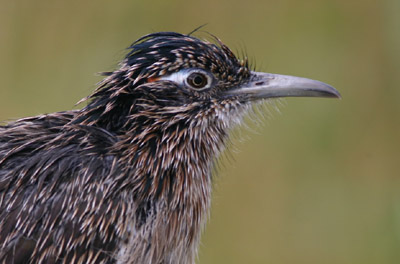Every child who has ever seen a cartoon featuring Wile E Coyote and Road Runner has to have wondered if poor Wile E  ever had a fair shot at catching the Road Runner. According to Mark Lockwood’s Basic Texas Birds: A Field Guide, with or without Wile. E. Coyote chasing it, a Greater Roadrunner can reach speeds of 20 MPH (32 KPH) while a Coyote can reach speeds of up to 43 MPH (69 KPH). Clearly, in an all out footrace, the roadrunner would be dinner.
ever had a fair shot at catching the Road Runner. According to Mark Lockwood’s Basic Texas Birds: A Field Guide, with or without Wile. E. Coyote chasing it, a Greater Roadrunner can reach speeds of 20 MPH (32 KPH) while a Coyote can reach speeds of up to 43 MPH (69 KPH). Clearly, in an all out footrace, the roadrunner would be dinner.
Of course, a couple facts get in the way of Wile E Coyote snacking on Road Runner. First of all, roadrunners have an amazing ability to use ground cover as they run and they rarely move in a straight line. Wild coyotes can’t expect roadrunners to actually stick to the road when their life is on the line! There is also the really pesky fact that roadrunners can fly. They prefer not to but if a coyote were about to catch a roadrunner that roadrunner would take to the wing and be gone!
Finally, despite what Warner Brothers would like you to believe, there has never been a documented instance of a coyote catching a roadrunner.** Shocking, no? Especially considering that coyotes are known to eat pretty much everything! It’s as if all the cartoons I watched as a child were just made up scenarios in pretend worlds with no actual relation to reality and no practical use whatsoever. Oh well.
It would seem that despite the greater speed of the coyote, and, considering its adaptability to multiple habitats, what is likely a greater native intelligence, that the roadrunner will somehow always stay one step ahead of its cartoon nemesis. To that, there is only one thing to say.
Meep-Meep!
Should a coyote someday catch a roadrunner the result would likely be something like this:
*Citation for Greater Roadrunner speeds found via Wikipedia’s Greater Roadrunner page and information about the top speed of a Coyote came via Fact Monster.
**Sentence edited after a correction in the comments.
…













Although there hasn’t been a documented instance of a coyote *catching* and eating a roadrunner (at least not that I’ve found), there are several accounts of roadrunners having been found in coyotes’ stomach contents and scat. While I suspect that most of the roadrunners consumed by coyotes are either carrion or taken as nestlings, I have little doubt that every once in a while a wily dog has his day.
@Michael MacDonald: Thanks for the info: I have changed the post to take your comment into account.
“It’s as if all the cartoons I watched as a child were just made up scenarios in pretend worlds with no actual relation to reality and no practical use whatsoever.”
They may have been made up scenarios in pretend worlds with no actual relation to reality, but they made you research the speed of a roadrunner and a coyote and had you analyse if a dog may occasionally have its day or not. That’s a practical use for me.
@Jochen: True. And I did laugh a lot as a kid at that hapless coyote.
I never enjoyed Roadrunner cartoons. The coyote’s life just struck me as so ….futile. I found the enjoyability factor of Daffy Duck to be much greater.
u should put a good pic of a roadrunner
Of course, Mr. Coyote had the ubiquitous Acme Company and its myriad products at his disposal, though never to his advantage. I also always wondered how he managed to pay for the Acme items he used. Another topic to research?
actually my dad was racing one we caught up to 80 mph and the road runner was farther than us
me and my firend was walking around with are class and we saw a roadrunner and we was talking to e loud, so it ran away. we was mad at my class we got in troudle, after the fire we went back to are caben,so all of are lights was of and we wasn’t talking at all we saw a lot………….i’am 11 years old and i love roadrunners.:]
40 miles phr
Of course you can not hunt a roadrunner…….It’s wabbit season.
thats false cause a coyote only goes 10 kph and a roadrunner 150 kph
plus on the looney tunes side its time to kill a pesky wabbit
The road runner run 42 km/h, no 32 km/h
Do coyotes really use Acme? Lmao.
DUCK SEASON!!
WABBIT SEASON!!
WABBIT SEASON!!